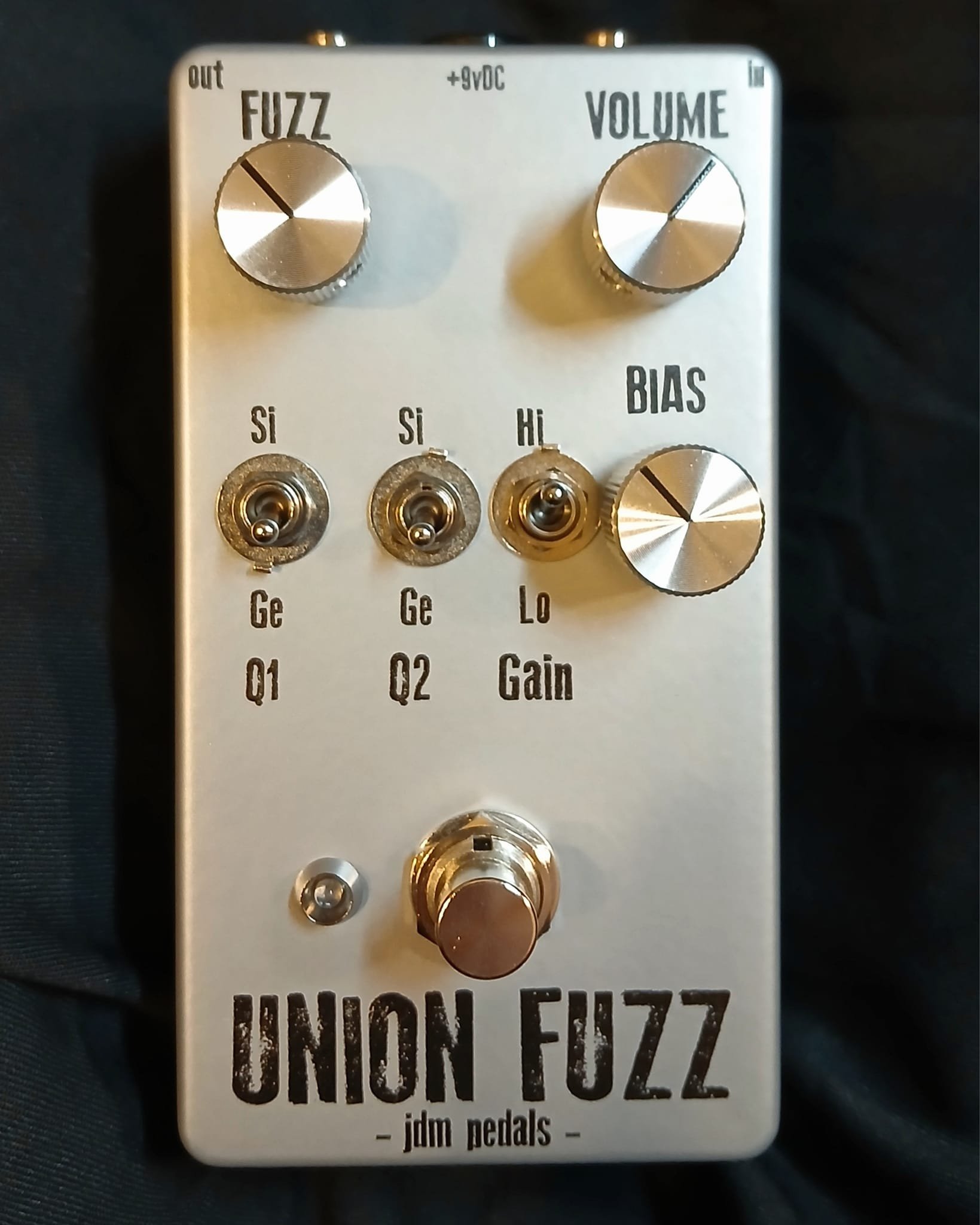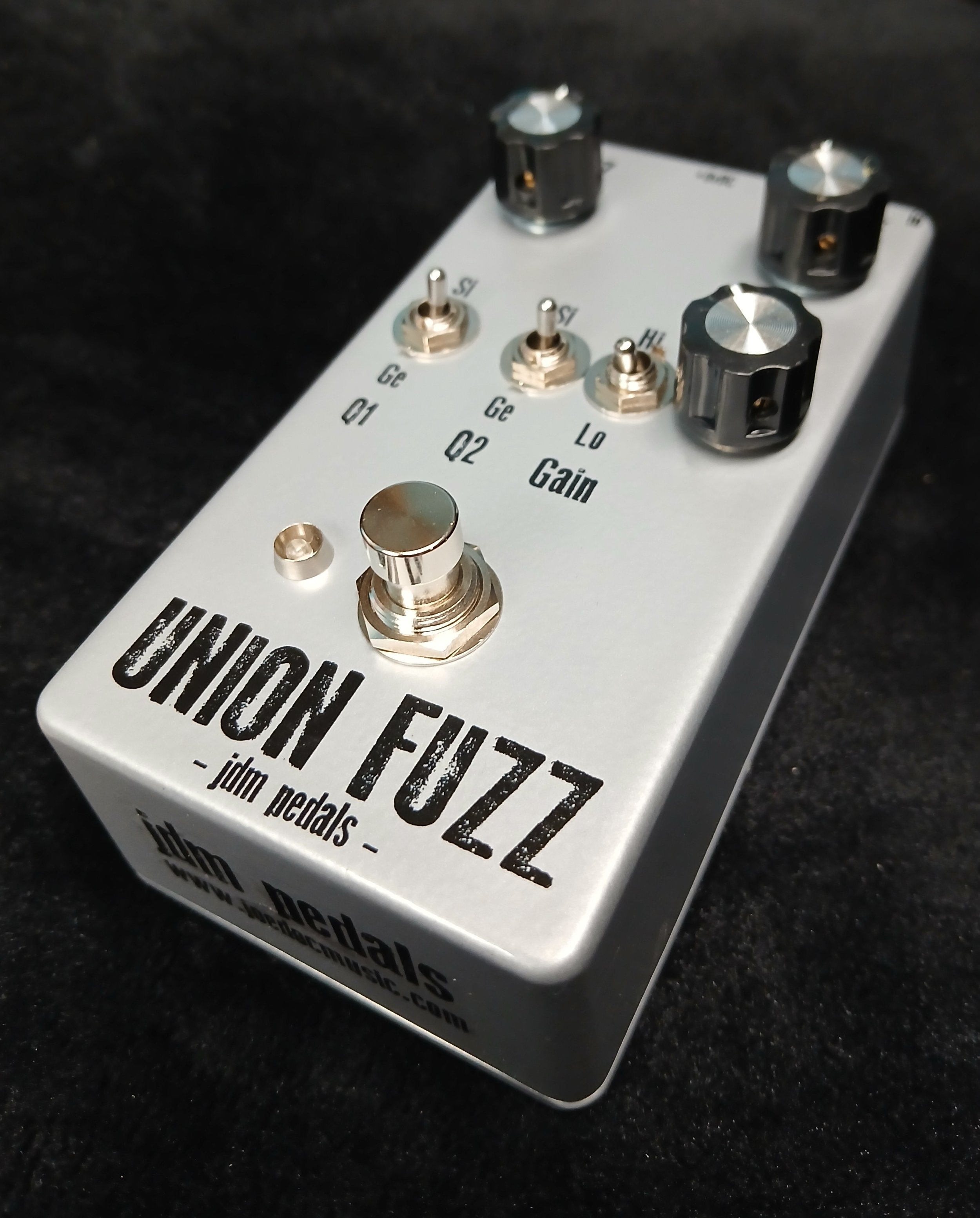JDM Union Fuzz
Silicon and germanium transistors create different shades of harmonically rich fuzz, and the Union Fuzz takes the classic "Fuzzface" circuit to another level of flexibility and reactivity.
Select between silicon or germanium transistors for both positions (“Q1” and “Q2”) as well as a “hi/lo” gain switch for a lower classic fuzz gain structure, 60’s style, or a higher gain 70’s style response.
In a two-transistor fuzz, the first stage provides the “drive” to the second transistor, but also affects the way your guitar interacts with the pedal. Silicon in “Q1” will drive the “Q2” transistor harder for a fuzzier tone, and is also brighter. Germanium Q1 creates a warmer tone that also cleans up even better with the guitar’s volume knob. In the Q2 position, go for a bright, cutting silicon character, or a thick and gooey germanium response. Each of the four possible combinations will be sure to inspire new ideas and fit into the mix in unique ways.
Additionally, the “bias” control dials in the harmonic content and sustain character. Lower settings are both more gated/sticky sounding, as well as adding more harmonics. Increase the bias control shapes a smoother, more overdrive-like tone.
Silicon and germanium transistors create different shades of harmonically rich fuzz, and the Union Fuzz takes the classic "Fuzzface" circuit to another level of flexibility and reactivity.
Select between silicon or germanium transistors for both positions (“Q1” and “Q2”) as well as a “hi/lo” gain switch for a lower classic fuzz gain structure, 60’s style, or a higher gain 70’s style response.
In a two-transistor fuzz, the first stage provides the “drive” to the second transistor, but also affects the way your guitar interacts with the pedal. Silicon in “Q1” will drive the “Q2” transistor harder for a fuzzier tone, and is also brighter. Germanium Q1 creates a warmer tone that also cleans up even better with the guitar’s volume knob. In the Q2 position, go for a bright, cutting silicon character, or a thick and gooey germanium response. Each of the four possible combinations will be sure to inspire new ideas and fit into the mix in unique ways.
Additionally, the “bias” control dials in the harmonic content and sustain character. Lower settings are both more gated/sticky sounding, as well as adding more harmonics. Increase the bias control shapes a smoother, more overdrive-like tone.
Silicon and germanium transistors create different shades of harmonically rich fuzz, and the Union Fuzz takes the classic "Fuzzface" circuit to another level of flexibility and reactivity.
Select between silicon or germanium transistors for both positions (“Q1” and “Q2”) as well as a “hi/lo” gain switch for a lower classic fuzz gain structure, 60’s style, or a higher gain 70’s style response.
In a two-transistor fuzz, the first stage provides the “drive” to the second transistor, but also affects the way your guitar interacts with the pedal. Silicon in “Q1” will drive the “Q2” transistor harder for a fuzzier tone, and is also brighter. Germanium Q1 creates a warmer tone that also cleans up even better with the guitar’s volume knob. In the Q2 position, go for a bright, cutting silicon character, or a thick and gooey germanium response. Each of the four possible combinations will be sure to inspire new ideas and fit into the mix in unique ways.
Additionally, the “bias” control dials in the harmonic content and sustain character. Lower settings are both more gated/sticky sounding, as well as adding more harmonics. Increase the bias control shapes a smoother, more overdrive-like tone.



